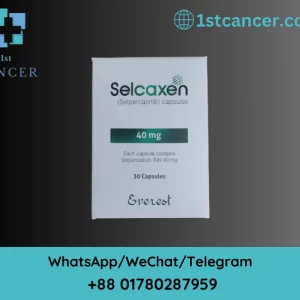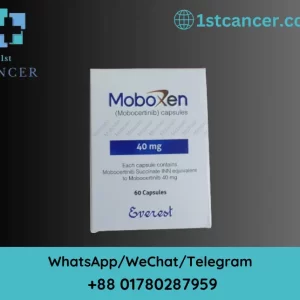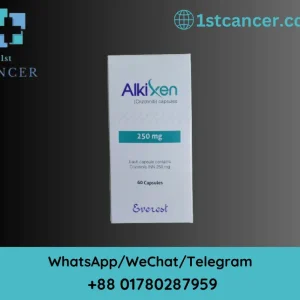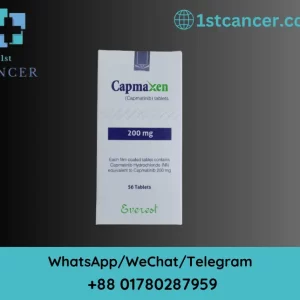In the relentless pursuit of effective oncologic interventions, the Lorlatinib Tablet emerges as a beacon of hope, particularly in the realm of precision oncology. As a third-generation tyrosine kinase inhibitor (TKI). Lorlatinib unfolds a compelling narrative in the management of certain types of cancer. Bringing with it a promise of enhanced efficacy and an innovative approach to targeting specific genetic aberrations. This active article delves into the details surrounding Lorlatinib Tablet. Exploring its background, mechanism of action, clinical applications, ongoing research, and potential side effects. Its position is at the forefront of emerging trends in oncology.
Introduction of Lorlatinib Tablet (Lorlagen):
In the dynamic landscape of oncology, the advent of Lorlatinib Tablet marks a transformative chapter in the quest for precision therapeutics. Positioned as a third-generation tyrosine kinase inhibitor (TKI),

Lorlatinib stands at the forefront of targeted interventions. Orchestrating a paradigm shift in the treatment of specific cancers. This introduction unfurls the narrative surrounding Lorlatinib, providing insights into its origins, and evolution. The promise it holds for patients navigating the complexities of oncologic care.
Origins and Evolution: A Response to Molecular Insights The inception of Lorlatinib Tablet is intricately tied to a deepening understanding of the molecular underpinnings of certain cancers. Research illuminated the pivotal role of genetic aberrations, particularly ALK and ROS1 mutations, in driving malignancies. The need for a precision therapeutic solution became evident. Lorlatinib emerged as a response to this imperative. Reflecting the evolution from the identification of key oncogenic drivers to the development of a targeted therapeutic agent.
Addressing Limitations of Previous TKIs:
A Step Forward in Precision Medicine Building upon the foundations laid by earlier generations of TKIs. Lorlatinib Tablet represents a leap forward in addressing their limitations. The journey from first-generation TKIs, such as crizotinib, to second-generation options like alectinib and ceritinib. Set the stage for Lorlatinib’s development. Recognizing the emergence of resistance and specific genetic mutations. Lorlatinib was meticulously crafted to overcome these challenges. Positioning itself as a precision tool to disrupt the molecular machinery driving cancer progression.
Mechanism of Action:
Precision Targeting for Therapeutic Precision Central to Lorlatinib’s efficacy is its sophisticated mechanism of action. Which intricately targets ALK and ROS1 mutations. As a selective TKI, Lorlatinib Tablet disrupts the aberrant signalling cascades initiated by these mutations. Ultimately halting the uncontrolled proliferation of cancer cells. Its unique ability to penetrate the blood-brain barrier enhances its effectiveness in managing metastatic disease. Particularly in the central nervous system—a domain where traditional therapies often face significant challenges.
Clinical Applications:
Revolutionizing ALK-Positive Cancers Lorlatinib’s primary clinical applications lie in its remarkable efficacy against ALK-positive cancers. Notably non-small cell lung cancer (NSCLC). Clinical trials have unveiled its potential as a therapeutic game-changer. Demonstrating effectiveness even in cases resistant to earlier-generation TKIs. The scope of Lorlatinib’s impact extends to the management of metastatic disease. Offering renewed hope for patients with ALK-driven malignancies.
As we embark on a detailed exploration of Lorlatinib Tablet. This introduction sets the stage for a comprehensive understanding of its origins, mechanism of action, and clinical applications. Ongoing research, potential side effects, and its role in the emerging trends of precision oncology. Lorlatinib’s journey unfolds against the backdrop of a dynamic landscape. Where targeted therapies like it redefine the contours of oncologic care. Promising a future marked by increased therapeutic precision and improved patient outcomes.
Background of Lorlatinib Tablet (Lorlagen):
The development of Lorlatinib Tablet is deeply rooted in the evolving landscape of precision oncology. A realm where scientific breakthroughs intersect with a profound understanding of genetic aberrations driving certain cancers. This section delves into the background of Lorlatinib Tablet, tracing its origins, and pivotal milestones in its development. The scientific rationale that propelled it into the forefront of targeted therapies.
Identification of Genetic Aberrations:
ALK and ROS1 Mutations The groundwork for Lorlatinib’s development was laid with the identification of specific genetic alterations as key drivers of oncogenesis. ALK (Anaplastic Lymphoma Kinase) and ROS1 (ROS Proto-Oncogene 1, Receptor Tyrosine Kinase) mutations emerged as focal points in certain cancers. Particularly non-small cell lung cancer (NSCLC). The recognition of these aberrations represented a critical juncture. Opening avenues for targeted interventions tailored to the molecular intricacies of individual tumours.
Limitations of Earlier Tyrosine Kinase Inhibitors (TKIs) First-generation TKIs like crizotinib paved the way for targeted therapy in ALK-positive cancers. Their efficacy was eventually hampered by the emergence of resistance mechanisms. This limitation led to the development of second-generation TKIs, including alectinib and ceritinib. However, the persistence of resistance, coupled with the need for an effective solution for central nervous system (CNS) metastases. Underscored the demand for a new therapeutic paradigm—ushering in the era of Lorlatinib Tablet.
Design and Development:
Overcoming Resistance and Penetrating the CNS Lorlatinib Tablet, a third-generation TKI, was meticulously designed to address the shortcomings of its predecessors. Its unique structure and pharmacokinetic properties enable it to overcome known resistance mutations. Providing a more comprehensive solution for ALK-positive cancers. Moreover, its ability to effectively penetrate the blood-brain barrier positions Lorlatinib as a potent weapon in managing metastatic disease. Particularly in the CNS—an area where traditional therapies often encounter challenges.
Clinical Trials:
Validation of Efficacy and Safety The journey from laboratory design to clinical implementation involved a series of pivotal trials that validated Lorlatinib’s efficacy and safety profile. Clinical trials, such as the phase I/II study (NCT01970865). Played a crucial role in establishing Lorlatinib Tablet as a promising therapeutic option. These trials not only demonstrated its effectiveness against ALK and ROS1 mutations but also provided insights into its tolerability. Dosing, and potential side effects.
Regulatory Approvals:
Navigating the Path to Clinical Utility Lorlatinib’s journey through the regulatory landscape culminated in approvals from health authorities such as the U.S. Food and Drug Administration (FDA) and the European Medicines Agency (EMA). These approvals marked a significant milestone. Officially recognizing Lorlatinib Tablet as a clinically viable option for patients with ALK-positive NSCLC. Reaffirming its position as a beacon of progress in precision oncology.
In summary, The background of Lorlatinib Tablet intertwines scientific discoveries. The recognition of genetic aberrations. The iterative process of overcoming therapeutic challenges in the landscape of precision oncology. As we delve deeper into Lorlatinib’s role in targeted cancer therapy. This background lays the foundation for understanding its significance in the evolving narrative of precision medicine.
Mechanism of Action Lorlatinib Tablet (Lorlagen):
Lorlatinib Tablet, is a third-generation tyrosine kinase inhibitor (TKI). Orchestrates its therapeutic impact through a sophisticated mechanism of action, finely tuned to disrupt specific oncogenic pathways. The precision with which Lorlatinib targets ALK (Anaplastic Lymphoma Kinase) and ROS1 (ROS Proto-Oncogene 1. Receptor Tyrosine Kinase) mutations distinguishes it as a formidable force in the realm of precision oncology.
-
Selective Inhibition of ALK and ROS1:
- Targeting the Culprits of Oncogenesis
Lorlatinib’s primary mission is to thwart the aberrant signaling cascades initiated by ALK and ROS1 mutations. These genetic alterations are recognized as pivotal drivers in certain cancers, particularly non-small cell lung cancer (NSCLC). By selectively inhibiting these mutated kinases. Lorlatinib interrupts the signalling pathways that fuel the uncontrolled growth and survival of cancer cells.
- Targeting the Culprits of Oncogenesis
-
Overcoming Resistance Mutations:
- A Response to Therapeutic Challenges
Lorlatinib Tablet distinguishes itself by its ability to overcome resistance mutations that may develop in response to earlier-generation TKIs. The ALK mutations L1196M, G1202R, and others pose challenges to treatment efficacy. Lorlatinib’s unique structure and binding properties allow it to circumvent these obstacles. This feature positions Lorlatinib as a valuable option for patients who have developed resistance to previous TKIs.
- A Response to Therapeutic Challenges
-
Penetration of the Blood-Brain Barrier:
- Addressing Central Nervous System Metastases
The blood-brain barrier poses a formidable challenge in the treatment of metastatic diseases, particularly in the central nervous system (CNS). Lorlatinib’s distinctive pharmacokinetic profile enables it to effectively penetrate the blood-brain barrier, making it a potent therapeutic agent for managing CNS metastases. This feature addresses a critical need in the comprehensive care of patients with advanced-stage cancers.
- Addressing Central Nervous System Metastases
-
Dual Inhibition of ALK and ROS1 Signaling:
- Maximizing Therapeutic Reach
Lorlatinib’s efficacy extends beyond its selective inhibition of ALK, encompassing dual inhibition of both ALK and ROS1 signaling pathways. This dual-targeted approach broadens its therapeutic reach, allowing Lorlatinib Tablet to intervene in cancers driven by either of these mutations. Such comprehensive targeting aligns with the personalized nature of precision medicine, tailoring therapeutic strategies to the specific genetic makeup of individual tumors.
- Maximizing Therapeutic Reach
-
Cell Cycle Arrest and Apoptosis Induction:
- Halting Uncontrolled Proliferation
Beyond kinase inhibition, Lorlatinib Tablet exerts its influence on cancer cells by inducing cell cycle arrest and apoptosis. By disrupting the cellular processes that lead to uncontrolled proliferation, Lorlatinib serves as a potent modulator of tumor growth. This multifaceted impact on cancer cell biology contributes to its effectiveness in impeding disease progression.
- Halting Uncontrolled Proliferation
Understanding Lorlatinib’s mechanism of action illuminates its role as a precision therapeutic agent, finely tuned to navigate the intricate molecular landscapes of ALK and ROS1-driven cancers. By selectively inhibiting these aberrant pathways, overcoming resistance, and penetrating sanctuary sites like the CNS, Lorlatinib Tablet stands as a testament to the strides made in precision oncology, offering renewed hope for patients facing the challenges of advanced-stage malignancies.
Clinical Uses of Lorlatinib Tablet (Lorlagen):
Lorlatinib, a beacon of precision oncology, has carved a distinct niche in clinical practice by virtue of its efficacy against ALK (Anaplastic Lymphoma Kinase) and ROS1 (ROS Proto-Oncogene 1, Receptor Tyrosine Kinase) mutations. As a third-generation tyrosine kinase inhibitor (TKI), Lorlatinib’s clinical utility extends across various scenarios, reshaping the treatment landscape for specific cancers, primarily non-small cell lung cancer (NSCLC).
-
ALK-Positive Non-Small Cell Lung Cancer (NSCLC):
- Frontline and Resistant Cases
Lorlatinib Tablet has emerged as a pivotal player in the treatment of ALK-positive NSCLC, both as a frontline therapy and in cases where resistance to earlier-generation TKIs has developed. In clinical trials, Lorlatinib demonstrated substantial efficacy, even in patients with ALK mutations resistant to prior TKIs. Its role as a first-line treatment option has been explored, offering a promising alternative for patients at different stages of their therapeutic journey.
- Frontline and Resistant Cases
-
Central Nervous System (CNS) Metastases:
- Addressing Challenges in CNS Involvement
The ability of Lorlatinib Tablet to penetrate the blood-brain barrier positions it as a frontline choice for patients with CNS metastases—a common and challenging aspect of advanced-stage cancers. Lorlatinib’s efficacy in managing brain metastases is a significant advancement, providing a targeted solution for patients with ALK or ROS1 mutations whose disease has spread to the CNS.
- Addressing Challenges in CNS Involvement
-
Resistance to Earlier-Generation TKIs:
- A Therapeutic Lifeline
Lorlatinib Tablet shines particularly bright in cases where resistance to earlier-generation TKIs, such as crizotinib, alectinib, or ceritinib, has developed. Its unique structure allows it to overcome resistance mutations, making it a valuable therapeutic lifeline for patients who may have exhausted other available options.
- A Therapeutic Lifeline
-
ROS1-Positive Cancers:
- Expanding the Therapeutic Horizon
Beyond its primary focus on ALK-positive cancers, Lorlatinib Tablet has shown promise in addressing ROS1-positive malignancies. Clinical studies are exploring Lorlatinib’s efficacy in ROS1-driven cancers, broadening its clinical applications and potentially offering a targeted therapeutic option for patients with this specific genetic aberration.
- Expanding the Therapeutic Horizon
-
Pediatric Oncology:
- Pioneering Pediatric Applications
Lorlatinib’s role in pediatric oncology is an area of active exploration. As the understanding of genetic drivers in pediatric cancers advances, the potential for Lorlatinib Tablet to play a transformative role in addressing specific mutations in young patients is being investigated. This opens new avenues for precision therapies in pediatric oncology, reflecting the adaptability of Lorlatinib across diverse demographics.
- Pioneering Pediatric Applications
-
Clinical Trials for Emerging Applications:
- A Landscape of Ongoing Exploration
The clinical utility of Lorlatinib Tablet is continuously evolving through ongoing research and clinical trials. Investigations into its efficacy in diverse genetic contexts, potential combination therapies, and its role in rare cancers underscore a commitment to expanding its clinical footprint and offering tailored solutions for a broader spectrum of patients.
- A Landscape of Ongoing Exploration
In conclusion, Lorlatinib’s clinical uses encompass a diverse array of scenarios in the oncologic landscape, from addressing ALK-positive NSCLC to pioneering applications in pediatric oncology. Its transformative impact in overcoming resistance, managing CNS metastases, and broadening the therapeutic horizon positions Lorlatinib as a pivotal player in the era of precision medicine, offering renewed hope for patients and redefining the possibilities in targeted cancer therapy.
Clinical Trials and Research of Lorlatinib Tablet (Lorlagen):
The journey of Lorlatinib Tablet extends beyond clinical practice, with a robust foundation built upon rigorous clinical trials and ongoing research initiatives. This section navigates through the pivotal trials that validated Lorlatinib’s efficacy and safety, offering insights into its evolving role and potential applications in diverse oncologic scenarios.
-
Phase I/II Trial (NCT01970865):
- Unveiling Safety and Early Efficacy
The Phase I/II trial served as a cornerstone, evaluating Lorlatinib’s safety and early efficacy in patients with ALK or ROS1-positive advanced NSCLC. This trial laid the groundwork for subsequent investigations, providing crucial data on dose escalation, side effect profiles, and initial responses. The findings not only affirmed Lorlatinib’s safety but also hinted at its potential as a potent therapeutic option.
- Unveiling Safety and Early Efficacy
-
Phase II Trial (NCT02143466):
- Efficacy in ALK-Positive NSCLC
Building upon the insights from the initial trials, the Phase II trial delved deeper into Lorlatinib’s efficacy specifically in ALK-positive NSCLC. This trial explored the drug’s impact on patients who had previously received one or more ALK inhibitors, shedding light on its role in overcoming resistance—a critical aspect of its clinical utility.
- Efficacy in ALK-Positive NSCLC
-
Phase III Trial (NCT03052608):
- Comparative Efficacy Studies
The Phase III trial represents a pivotal step in Lorlatinib’s journey, directly comparing its efficacy against crizotinib in treatment-naive patients with ALK-positive NSCLC. This head-to-head trial provided crucial data for clinicians and regulatory bodies, informing decisions regarding Lorlatinib’s role as a frontline therapy and its potential advantages over established treatments.
- Comparative Efficacy Studies
-
Pediatric Phase I/II Trial (NCT03107988):
- Exploring Pediatric Applications
Recognizing the potential for Lorlatinib Tablet in pediatric oncology, a dedicated Phase I/II trial in pediatric patients with advanced ALK-driven malignancies was initiated. This trial seeks to unravel Lorlatinib’s safety, pharmacokinetics, and early efficacy in a younger demographic, paving the way for tailored precision therapies in pediatric oncology.
- Exploring Pediatric Applications
-
Ongoing Trials and Combinatorial Approaches:
- A Landscape of Exploration
Beyond completed trials, ongoing research endeavors continue to shape Lorlatinib’s narrative. Investigations into its efficacy in ROS1-positive cancers, its role in combination therapies with other targeted agents, and applications in rare oncologic scenarios underline a commitment to expanding Lorlatinib’s therapeutic frontiers.
- A Landscape of Exploration
-
Real-World Evidence Studies:
- Translating Clinical Insights into Practice
Complementing traditional clinical trials, real-world evidence studies contribute valuable insights into Lorlatinib’s performance in routine clinical practice. These studies, often involving diverse patient populations and varied clinical settings, provide a nuanced understanding of Lorlatinib’s impact beyond controlled trial environments.
- Translating Clinical Insights into Practice
In conclusion, Lorlatinib’s journey through clinical trials and ongoing research reflects a dynamic landscape of exploration and innovation. From its early safety assessments to comparative efficacy studies and pediatric applications, each trial contributes to a comprehensive understanding of Lorlatinib’s role in precision oncology. As research unfolds, the collective findings continue to guide clinicians, inform treatment decisions, and illuminate the evolving possibilities in the targeted management of ALK and ROS1-driven cancers.
Potential Side Effects of Lorlatinib Tablet (Lorlagen):
While Lorlatinib Tablet holds promise as a potent therapeutic agent in the realm of precision oncology, its clinical utility is accompanied by a spectrum of potential side effects. Vigilant monitoring and a nuanced understanding of these adverse events are crucial components of Lorlatinib therapy, ensuring a balanced risk-benefit assessment for patients undergoing treatment.
-
Gastrointestinal Disturbances:
- Addressing Common Symptoms
Lorlatinib Tablet commonly causes gastrointestinal disturbances, including nausea, diarrhoea, and abdominal pain. While these symptoms are generally manageable, clinicians may employ proactive measures such as prescribing antiemetic medications and recommending dietary adjustments to alleviate patient discomfort.
- Addressing Common Symptoms
-
Hypercholesterolemia:
- Monitoring Lipid Profiles
Lorlatinib Tablet has been associated with an increased risk of hypercholesterolemia, necessitating regular monitoring of lipid profiles during therapy. Clinicians may employ lipid-lowering agents or dietary modifications to manage elevated cholesterol levels and mitigate cardiovascular risks.
- Monitoring Lipid Profiles
-
Hypertriglyceridemia:
- A Lipid-Related Side Effect
Elevated triglyceride levels represent another potential lipid-related side effect of Lorlatinib Tablet. To address hypertriglyceridemia and mitigate associated cardiovascular risks, healthcare providers should closely monitor patients and proactively implement lifestyle modifications and pharmacological interventions.
- A Lipid-Related Side Effect
-
Peripheral Edema:
- Managing Fluid Retention
Lorlatinib Tablet therapy has been linked to peripheral edema, a condition characterized by the accumulation of fluid in the extremities. Clinicians may employ diuretics and lifestyle modifications to manage edema and improve patient comfort during the course of treatment.
- Managing Fluid Retention
-
Pulmonary Adverse Events:
- Vigilance in Monitoring Respiratory Function
Close monitoring of respiratory function is crucial for patients receiving Lorlatinib Tablet therapy, as pulmonary adverse events, such as dyspnea and cough, have been reported. If these symptoms manifest, indicating potential respiratory compromise, prompt intervention is warranted.
- Vigilance in Monitoring Respiratory Function
-
Hepatotoxicity:
- Monitoring Liver Function
Association with hepatotoxicity has been noted with Lorlatinib, necessitating regular monitoring of liver function through laboratory assessments. Clinicians may adjust treatment or employ supportive measures if they observe signs of liver dysfunction, such as elevated liver enzymes.
- Monitoring Liver Function
-
Hypertension:
- Blood Pressure Management
Hypertension is a potential side effect of Lorlatinib Tablet, and blood pressure should be closely monitored throughout the course of therapy. Antihypertensive medications and lifestyle modifications may be utilized to manage elevated blood pressure and mitigate associated cardiovascular risks.
- Blood Pressure Management
-
Bradycardia:
- Monitoring Cardiac Function
Lorlatinib Tablet therapy may lead to bradycardia, a slower-than-normal heart rate. Regular monitoring of cardiac function, including electrocardiograms, is essential, and clinicians may intervene with appropriate measures if significant bradycardia is observed.
- Monitoring Cardiac Function
-
Visual Disturbances:
- Cataract Formation
Lorlatinib is associated with visual disturbances, including the development of cataracts. Regular ophthalmologic assessments are recommended to detect and manage cataracts, ensuring optimal visual health for patients undergoing long-term therapy.
- Cataract Formation
-
Neurological Adverse Events:
- CNS-Related Symptoms
Given Lorlatinib’s ability to penetrate the blood-brain barrier, neurological adverse events, including mood alterations and cognitive effects, may occur. Clinicians should be vigilant in monitoring patients for these symptoms and consider appropriate interventions as needed.
- CNS-Related Symptoms
Understanding and proactively managing these potential side effects are integral to optimizing the safety and tolerability of Lorlatinib Tablet therapy. Close collaboration between patients and healthcare providers, coupled with ongoing monitoring, allows for the timely identification and management of adverse events, ensuring that the benefits of Lorlatinib in targeted cancer therapy outweigh the potential risks.
Emerging Trends and Developments of Lorlatinib Tablet (Lorlagen):
As Lorlatinib continues to establish its role as a transformative force in precision oncology, emerging trends and developments are shaping its trajectory, reflecting a dynamic landscape of innovation and exploration. This section delves into the evolving narrative of Lorlatinib, exploring current trends that are redefining its applications, accessibility, and potential impact on the future of targeted cancer therapy.
-
Combination Therapies and Synergistic Approaches:
- Maximizing Therapeutic Efficacy
An emerging trend in Lorlatinib Tablet research involves investigating its efficacy in combination with other targeted agents or immunotherapies. Combinatorial approaches aim to enhance the therapeutic efficacy, overcome resistance mechanisms, and potentially broaden the scope of Lorlatinib’s applications in diverse oncologic scenarios. Clinical trials exploring these synergistic strategies are paving the way for personalized and optimized treatment regimens.
- Maximizing Therapeutic Efficacy
-
Extended Applications Beyond ALK and ROS1:
- Exploring Novel Indications
Ongoing research initiatives are exploring Lorlatinib’s efficacy in cancers beyond its primary focus on ALK and ROS1 mutations. Investigating its impact in rare genetic contexts and diverse molecular landscapes opens avenues for extending its applications, potentially broadening its utility to a wider range of patients with specific genetic aberrations.
- Exploring Novel Indications
-
Pediatric Oncology Advancements:
- Tailored Solutions for Young Patients
The exploration of Lorlatinib’s role in pediatric oncology represents a significant trend. Research endeavors are unraveling its safety, efficacy, and potential applications in young patients with ALK-driven malignancies, offering the prospect of tailored precision therapies for pediatric populations.
- Tailored Solutions for Young Patients
-
Real-World Evidence and Long-Term Safety Profiles:
- Insights Beyond Clinical Trials
The accumulation of real-world evidence is becoming increasingly significant in understanding Lorlatinib’s long-term safety profiles and performance in routine clinical practice. Real-world studies contribute valuable insights into patient populations not always represented in clinical trials, offering a more comprehensive understanding of Lorlatinib’s impact beyond controlled environments.
- Insights Beyond Clinical Trials
-
Biosimilars and Access to Therapy:
- Enhancing Accessibility
The emergence of biosimilars for targeted therapies like Lorlatinib is an ongoing trend, aiming to enhance accessibility and affordability. These developments hold the potential to increase the availability of Lorlatinib to a broader patient population, addressing challenges related to cost and ensuring equitable access to cutting-edge precision therapies.
- Enhancing Accessibility
-
Patient-Centric Outcomes and Quality of Life Measures:
- Holistic Approaches to Care
Emerging trends in Lorlatinib Tablet research include a heightened focus on patient-reported outcomes and quality of life measures. Understanding the holistic impact of Lorlatinib on patients’ lives, beyond traditional clinical endpoints, provides a more nuanced understanding of its overall therapeutic value and guides patient-centered care.
- Holistic Approaches to Care
-
Biomarker Exploration for Predictive Responses:
- Advancing Precision Medicine
Biomarker exploration remains a trend at the forefront of Lorlatinib research. Identifying predictive biomarkers for treatment response not only refines patient selection but also contributes to the advancement of precision medicine. Tailoring Lorlatinib therapy based on specific genetic and molecular profiles enhances its effectiveness and minimizes unnecessary exposure for non-responders.
- Advancing Precision Medicine
-
Global Collaborations and Multinational Trials:
- Fostering Collaborative Research
Multinational collaborations and trials mark the global landscape of Lorlatinib research. Engaging diverse patient populations and harnessing collective expertise from various regions contribute to a more comprehensive understanding of Lorlatinib’s performance in different genetic contexts, ensuring its relevance on a global scale.
- Fostering Collaborative Research
As Lorlatinib continues to navigate these emerging trends and developments, it remains a pivotal player in the evolving narrative of precision oncology. From innovative combination therapies to the exploration of novel indications, Lorlatinib’s journey reflects a commitment to pushing the boundaries of what is achievable in targeted cancer therapy, offering hope and tailored solutions to patients confronting the complexities of advanced-stage malignancies.
Conclusion of Lorlatinib Tablet (Lorlagen):
In the realm of precision oncology, Lorlatinib emerges as a beacon of innovation, reshaping the narrative of targeted cancer therapy. From its origins as a response to ALK (Anaplastic Lymphoma Kinase) and ROS1 (ROS Proto-Oncogene 1, Receptor Tyrosine Kinase) mutations to its current status as a transformative force, Lorlatinib has traversed a remarkable journey, leaving an indelible mark on the landscape of precision medicine.
Transformative Impact on ALK-Positive NSCLC:
Lorlatinib’s primary clinical use in ALK-positive non-small cell lung cancer (NSCLC) showcases its transformative impact. Its efficacy as both a frontline treatment and a lifeline for those resistant to earlier-generation tyrosine kinase inhibitors (TKIs) underscores its versatility. The ability to overcome resistance mutations, manage central nervous system (CNS) metastases, and demonstrate effectiveness in diverse scenarios cements Lorlatinib’s role as a cornerstone in ALK-positive NSCLC management.
Addressing Therapeutic Challenges:
One of Lorlatinib’s distinctive features lies in its ability to navigate therapeutic challenges, overcoming resistance mutations that often impede the efficacy of earlier TKIs. Its sophisticated mechanism of action, dual inhibition of ALK and ROS1, and penetration of the blood-brain barrier address critical challenges in the treatment landscape, offering renewed hope to patients facing advanced-stage malignancies.
Beyond ALK and ROS1:
As emerging trends suggest, Lorlatinib is not confined to its initial targets. Ongoing research explores its efficacy in broader genetic contexts, potentially expanding its applications to cancers beyond ALK and ROS1. The exploration of Lorlatinib in pediatric oncology and its investigation in combination therapies highlights the adaptability of this precision therapeutics in diverse clinical scenarios.
Patient-Centric Care and Quality of Life:
The evolving landscape of Lorlatinib research underscores a commitment to patient-centric care. Beyond clinical endpoints, the focus on patient-reported outcomes and quality-of-life measures acknowledges the holistic impact of Lorlatinib on individuals navigating the complexities of cancer treatment.
Global Collaboration and Accessibility:
Lorlatinib’s journey is not confined to a singular region. Global collaborations and multinational trials contribute to a more nuanced understanding of its performance across diverse patient populations. The emergence of biosimilars aims to enhance accessibility, ensuring that Lorlatinib’s benefits are accessible to a wider demographic, addressing challenges related to cost and availability.
Looking Ahead:
Lorlatinib continues to lead the way in the landscape of precision oncology, marked by ongoing research, clinical trials, and an unwavering commitment to advancing the frontiers of targeted therapy on the road ahead. The exploration of biomarkers, novel indications, and combination therapies positions Lorlatinib at the forefront of the relentless pursuit of advancements in cancer care.
In conclusion, Lorlatinib stands not only as a therapeutic intervention but as a symbol of progress in precision medicine—a testament to what is achievable when scientific innovation converges with a deep understanding of the genetic intricacies driving cancer. As Lorlatinib continues to shape the future of targeted cancer therapy, it offers a glimpse into a future where precision-tailored treatment, providing hope and improving outcomes, takes center stage in patients’ journeys toward recovery.





